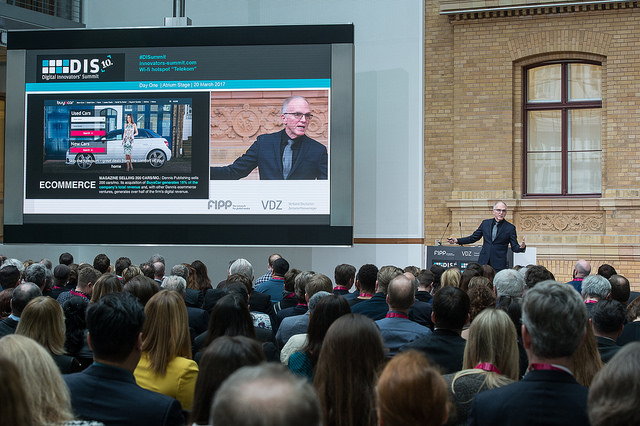Top media innovations from around the world discussed at DISummit
Wilpers launched and introduced FIPP and Innovation Media Consulting's Innovation in Magazine Media 2017-2018 World Report on the main stage at Digital Innovators' Summit.
The new report highlights how, over the last 12 months, the media landscape has changed in myriad ways. It focuses on technology, apps, monetisation strategies, native advertising, progressive web apps, quirky and offbeat innovations from magazine media around the world, offering publishers ideas, strategies and solutions to issues they face. Another powerful creation from editors John Wilpers and Juan Señor of Innovation Media Consulting Group, a global consultancy helping publishers succeed in the digital age.
"Eight years ago, we had absolutely no idea where we were going or how to get there," Wilpers said. "Now, we have a very good sense of where we're going and how we're going to get there."
The future, according to Wilpers, lies in messaging apps and chatbots. Messaging apps are conversation platforms like WeChat, WhatsApp, Facebook Messenger, Viber and Kik, designed to facilitate conversation between friends. Chatbots are interactive apps that live on messaging apps. And, there are two kinds of chatbots: the kind that are pre-programmed to answer specific questions publishers have already anticipated, and also a type of chatbot that is based on machine-learning and learns as the conversation moves along.
"Forty million people use a chatbot called Xiaoice in China, and 10 million of them said they loved her," Wilpers said. "It's not a her! It's not a person! But, the AI (artificial intelligence] remembered a conversation about a girlfriend or a job interview, and asked about it the next time that person came back."
Publishers can profitably play in these areas, and have begun to experiment with chatbots, according to Wilpers.
National Geographic Kids launched a chatbot for Facebook Messenger last year, called Tina the T-Rex, to teach kids about dinosaurs. Tina the T-Rex answers from a pre-programmed script. Chatbots appeal to companies outside of publishing as well: large companies like Disney and Mattel are actively using chatbots to spur conversations with audiences, to drive sales and raise brand awareness.
Messaging apps and chatbots could be an investment for publishers of all sizes and scales. From a content perspective, a chatbot is another platform for publishers to find content for, but it is achievable by using service journalism already produced by the brand.
However, chatbots are still an experimental area for many, and Wilpers believes they are a platform publishers need to investigate. "With the caveat being if you don't figure out who your readers are, and if this is appropriate, then you're going to spend a lot of money on things that aren't going to work," he said.
However, there is a delicate balance involved in moving into messaging apps and chatbots. Stepping into people's personal conversations is a quick way to get blocked, deleted, or abandoned. "Interrupting the daily lives of readers is like butting into a conversation at a cocktail party. You're not invited," Wilpers explained. "You have to be respectful. You have to be offering something of value to the conversation. If we find messaging app groups built around interests that we are experts in, then we can add value to it."
Mobile "precision" content
One of the areas Wilpers touched on was precision content, "content that is appropriate for and relevant to the consumer's needs at the moment," in the format and on the platform of the moment. Precision content speaks to a fundamental shift in how consumers engage with and consume content, meeting the unique needs of consumers and the characteristics of mobile.
Mobile "precision content" must be done right. Stories we tell as publishers must combine both the gut instinct of editors, and also use data to make these editorial decisions. Readers want certain types of content throughout the day. Content must be planned around these 'use cases.' "Readers' content needs are diverse, they change throughout the day, they are situation-specific, and they are both restricted and enhanced by the platform the reader is using at the moment," according to Wilpers.
Indeed, as he outlined, the overall experience for consumers on mobile platforms is essential. If it doesn't satisfy, adblocking becomes a problem. Adblocking in Europe and the Americas is happening because of abuse of the user on a mobile app - dumping desktop and banner ads loaded with all kinds of images and non-optimised data-seeking scripts that slow down the load of the page.
"Mobile abandonment is happening," Wilpers explained. "No longer are they not coming back, now, they're blocking."
To top that, app fatigue may be settling in among audiences. "By 2014, the majority of Americans were downloading zero apps per month, according to ComScore," wrote Casey Newton, editor of The Verge.
To solve that problem, Wilpers offered a solution: progressive web apps (PWAs).
Unlike native apps, PWAs are responsive, web-based apps that are cheap to build, safe, fast and discoverable. They work just as well online as off and are indexable by search engines, which makes them discoverable. There is no downside to PWAs as your mobile website becomes your app, according to Wilpers.
"A PWA is one of those no-brainers that come along once in a blue moon," Wilpers said. "If you don't have a native app, go straight to building a PWA. You won't regret it."
Monetisation
"Today, we have a rich buffet of monetisation options," he explained. As there is no one silver bullet, Wilpers outlined 14 monetisation options, to give publishers material to explore. (If you buy the 2017-2018 Innovation Report, you can read about all 14 of the monetisation options for publishers.) In the 40-page chapter devoted to monetisation, options include advertising, ad blocking, branded content, ecommerce, events, distributed content, messaging apps and chatbots, mobile and native advertising, newsletters, programmatic advertising, reader revenue, retail revenue, and video advertising.
"We're all facing an inevitable transition - and many people have already made it - from advertising-based support to reader revenue," he said. "I think convincing your readers you are producing content of great value that they can't get anywhere else, and should pay for, is the ultimate solution."
A monetisation option for publishers of all shapes and sizes include events, which can be incredibly profitable. "Particularly for niche publishers, who know the turf, the people, the advertisers, profit margins for events is about 40 per cent," Wilpers said.
Newsletters are also a promising monetisation option outlined in the report, suitable for niche publishers. It's another case of niche expertise being marketable, Wilpers explained. Newsletters are making a comeback, as they deliver web traffic, subscriptions, brand awareness, donations, advertising, and subscription packages. Newsletters also build community. "Niche newsletters can target particular passions and thereby develop deeper links to audiences in that community of shared interests, and gradually build a relationship, foster loyalty and, ultimately, offer membership and tickets to events," Wilpers wrote.
Tech
The media landscape continues to change and shift - from print to digital, from digital to mobile, from mobile to chat platforms - and behind all of the shifts is technology.
Which tools should magazine media use, and how should they use them?
Every day, it seems, there are new options to explore. So, Wilpers allocated an entire chapter - of 30 pages - to explore 10 technology options. "My aim is to inspire and provoke your curiosity, giving you enough information to make a decision to pass or to explore further on your own," he wrote.
The biggest piece of technology publishers need to be paying attention to, using, and guiding strategy with, is analytics. While publishers may have a lot of data, they don't know how best to analyse it. Enter in a new tool - the device graph.
A device graph is important to publishers and advertisers, as they measure actions across devices and can be much more targeted in nature. "Device graphs enable publishers and advertisers to see the journey of a consumer across his or her devices," Wilpers explained. "You can see where and when the decision happened, to subscribe or buy or take an action, as opposed to not knowing."
With device graphs, publishers and advertisers are able to see what stories and features audience members looked at, what drove them to take an action, and did it drive other people, and can that pattern be repeated in ways that will influence other people like them?
Another trend in technology that has staying power is the voice-activated personal assistant. Considered "the next big thing," voice-activated personal assistants, like Google Home, Microsoft's Cortana, Amazon Echo's Alexa, or Google Assistant can deliver content wherever a consumer is, whether they have access to a screen and keyboard or not. Voice-activated personal assistants are mostly used for personal assistance (like errands, online bookings, creating lists and appointments), for fun and entertainment, for general information and for local information.
"The concern with voice-activated personal assistants, much like when publishers began to create their own websites and write their own content, is that it is another platform for content, and if we let ourselves get beaten to the punch then recovery will be hard," Wilpers said. "Do you have content you can put on these platforms your readers will find of value?"
Culture
While the new Innovation in Magazine Media 2017-2018 World Report offers a lot of information on innovations around the world, it also chronicles a change in momentum in the media landscape. "The speed and depth and breadth of all of the changes in our industry continues to crescendo with no sign of letting up," Wilpers said. "As a result, only the media companies willing to radically and thoroughly reimagine their entire organisation, from org charts and job descriptions to work flows, training, publishing schedules, equipment, data use, working spaces, etc. will survive and thrive in the dramatically different media world."
Order your copy of the Innovation in Magazine Media 2017-2018 World Report here.
FIPP members: Digital: Free | Print: £69 | Print + Digital: £69
Non-members: Digital: £129 | Print £129 | Print + Digital: £159
John Wilpers and Juan Señor of Innovation Media Consulting Group are available to present the case studies included in the report to your teams at your companies or to regional media associations. If you wish to bring innovation home, or want to order a bulk order at discounted rates, please contact Helen Bland at FIPP.





